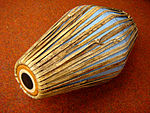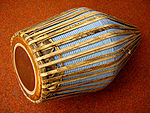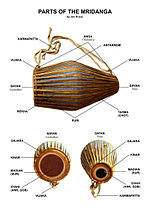- Khol
-
For the Austrian politician, see Andreas Khol. For KHOL, a radio station in Jackson Hole, Wyoming, see KHOL.
- This article is about khol, Indian drum. See also mridangam drum.
-
- For other terms, see kohl.
The khol (Bengali,খোল)(Assamese,খোল) also known as a mrdanga (lit. "mrit+anga" = "clay body") or mridanga (not to be confused with mridangam) is a terracotta two-sided drum used in northern and eastern India for accompaniment with devotional music (bhakti). It originates from the Indian state West Bengal Assam and Manipur.Contents
Introduction
One of the sides of the khol is much smaller than the other. Both sides are covered with naturally dead cow or goat skin. The smaller head (the dayan) and the bigger bass head (the baya) are usually three-layered heads in addition to a special central region of rice paste, glue, and iron known as the syahi. The drum is played with palms and fingers of both hands. It was created by Sri Caitanya Mahaprabhu in Bengal more than 500 years ago.
Gaudiya Nritya
It is used to accompany Bengali Kirtons by medieval poets like Chandidas, Govindadasa and Gyanadas. It is also used to accompany Gaudiya Nritya, one of the nine Indian Classical Dances.
In ISKCON and in Gaudiya Vaishnava societies, the khol is the primary drum for bhajan, it is very dear to Lord Krishna & his devotees.
Mahapurush Srimanta Sankaradeva
Mahapurush Srimanta Sankaradeva also used Khol, Mridanga for Gayan-Bayan, Borgeet and Sattriya Nritya in addition it is also used in Dihanaam.
Balarama mridanga
As khols became popular in the West, many varieties of khols resulted. The traditional clay khol gave rise to a fiberglass skinned khol (same as clay with only a fiberglass body), a brass khol (same as clay with only a brass body), and Balarama mridanga (a mridanga with a fiberglass body and plastic heads).
See also
External links

This article relating to percussion instruments is a stub. You can help Wikipedia by expanding it.



